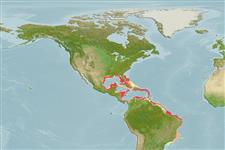>
Eupercaria/misc (Various families in series Eupercaria) >
Labridae (Wrasses) > Corinae
Etymology: Halichoeres: Greek, als, alis = salt + Greek, choiros = pig (Ref. 45335).
More on author: Bloch.
Environment: milieu / climate zone / depth range / distribution range
Ecologia
marino associati a barriera corallina; distribuzione batimetrica 18 - 91 m (Ref. 7251), usually 30 - ? m (Ref. 52607). Tropical; 30°N - 33°S, 98°W - 32°W
Western Atlantic: Florida, USA and Antilles to Brazil.
Size / Peso / Age
Maturity: Lm ? range ? - ? cm
Max length : 30.0 cm TL maschio/sesso non determinato; (Ref. 7251)
Spine dorsali (totale) : 9; Raggi dorsali molli (totale) : 12; Spine anali: 3; Raggi anali molli: 12. Juveniles and females yellow with broad blue stripe from eye to center of caudal fin. The only Halichoeres species in Caribbean region with 12 dorsal rays, all other have 11 (Ref. 26938). Adults with a broad black stripe on upper half of body; narrowing as it passes posteriorly to end in middle of caudal fin; lower half of body light blue-green; head below level of mouth blue-green, above yellow (Ref. 13442).
Found over hard substrates (Ref. 9626). Juveniles up to 8 cm act as specialized cleaners. Each individual tends a defined cleaning station sought by several species of reef fishes including damselfishes, goatfishes, and surgeonfishes. At the cleaning station this wrasse swims in a characteristic seesaw motion (Ref. 31373). Occasionally caught by anglers. Generally of no interest to fisheries because of its small average size (Ref. 5217). Found at 9 m in Belize (Ref. 26938).
Life cycle and mating behavior
Maturities | Riproduzione | Spawnings | Egg(s) | Fecundities | Larve
Distinct pairing during breeding (Ref. 205).
Robins, C.R. and G.C. Ray, 1986. A field guide to Atlantic coast fishes of North America. Houghton Mifflin Company, Boston, U.S.A. 354 p. (Ref. 7251)
IUCN Red List Status (Ref. 130435)
Threat to humans
Harmless
Human uses
Pesca: commerciale; Pesce da pesca sportiva: si; Acquario: Commerciale
Strumenti
Special reports
Download XML
Fonti Internet
Estimates based on models
Preferred temperature (Ref.
123201): 21.1 - 27.6, mean 25.4 °C (based on 91 cells).
Phylogenetic diversity index (Ref.
82804): PD
50 = 0.5000 [Uniqueness, from 0.5 = low to 2.0 = high].
Bayesian length-weight: a=0.00955 (0.00451 - 0.02020), b=3.09 (2.92 - 3.26), in cm total length, based on LWR estimates for this Genus-body shape (Ref.
93245).
Trophic level (Ref.
69278): 3.6 ±0.54 se; based on food items.
Resilienza (Ref.
120179): Medio, tempo minimo di raddoppiamento della popolazione 1.4 - 4.4 anni (Preliminary K or Fecundity.).
Fishing Vulnerability (Ref.
59153): Low vulnerability (20 of 100).
Nutrients (Ref.
124155): Calcium = 52.1 [30.7, 86.4] mg/100g; Iron = 0.669 [0.392, 1.226] mg/100g; Protein = 18.3 [15.5, 20.5] %; Omega3 = 0.153 [0.097, 0.239] g/100g; Selenium = 32 [18, 57] μg/100g; VitaminA = 173 [57, 594] μg/100g; Zinc = 1.27 [0.88, 1.93] mg/100g (wet weight);
